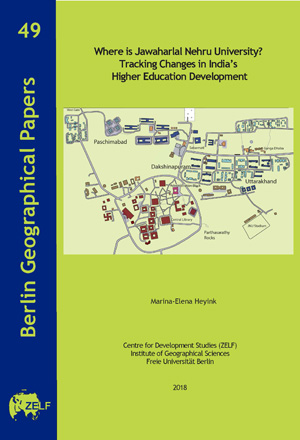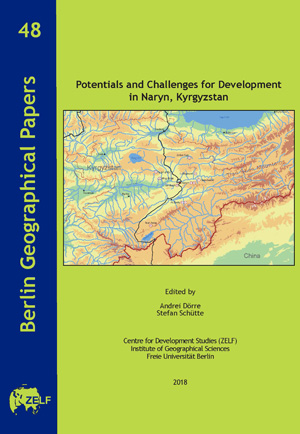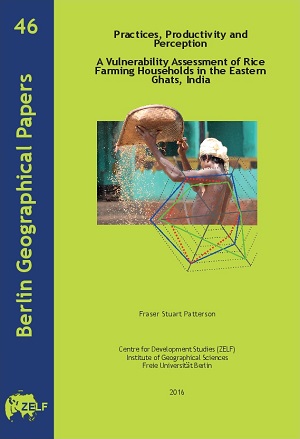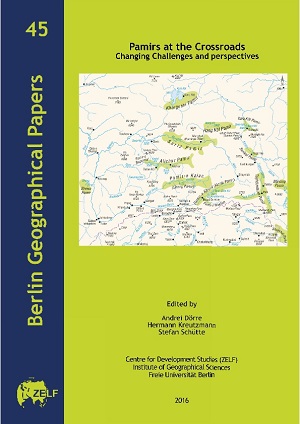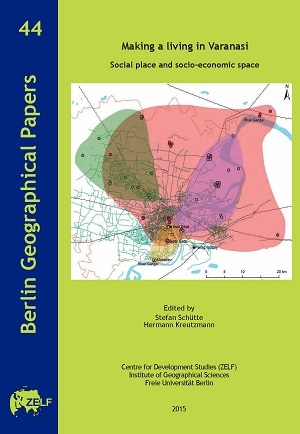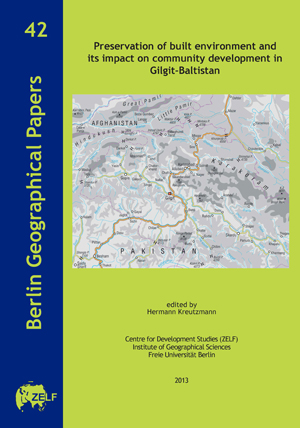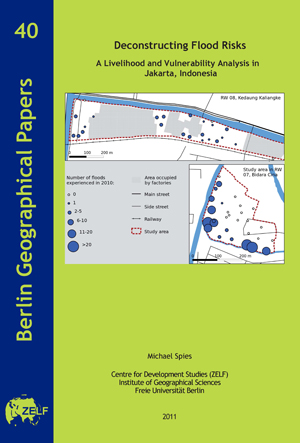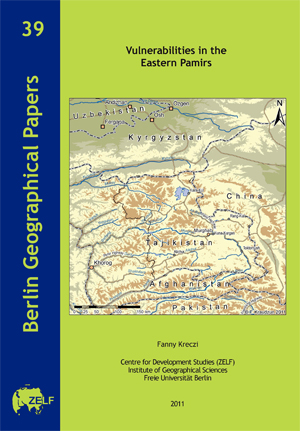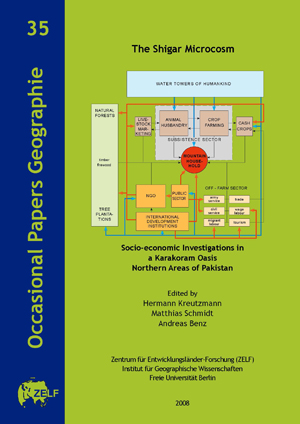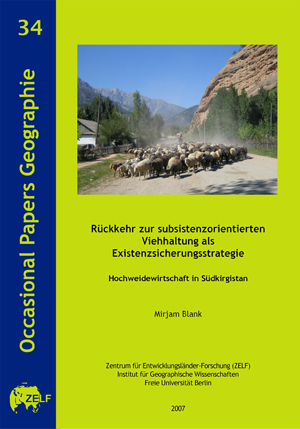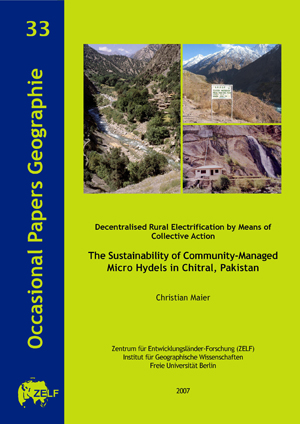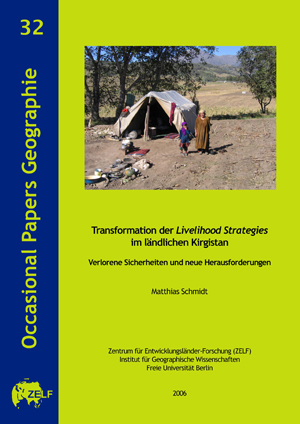Berlin Geographical Papers
Berlin Geographical Papers (seit Band 36; ehemals Occasional Papers Geographie)
Die Reihe der Berlin Geographical Papers veröffentlicht die Ergebnisse von aktuellen Forschungsprojekten am Centre for Development Studie der Freien Universität Berlin. Der regionale Schwerpunkt liegt auf Asien mit besonderem Fokus auf Süd- und Zentralasien. Die Reihe hat das Ziel der schnellen Kommunikation von Forschungsergebnissen an eine interessierte Öffentlichkeit.
Ab Band 50 sind die Berlin Geographical Papers über Refubium - das Repositorium der FU Berlin zugänglich.
##plugins.themes.ubOmpTheme01.alreadyPublished##
Where is Jawaharlal Nehru University? Tracking Changes in India's Higher Education Development
In recent years, the phenomenon of nationalism has evoked much attention when negotiating the institutional design of India’s universities. Justifiably rejecting the political project of naturalizing or essentializing the concepts of nation and nationhood, critical public and scientific discourse, however, often reduces nationalism to its symbolic or idealistic dimension. On the contrary, material structures of public institutional spaces have received little geographical attention when approaching national ideals, aspirations, conflicts, and controversies. This is despite the fact that constructed environments and spatial designs form a substantial link between the nation state of India and its public higher education in institutions. Arguing that space makes a difference, the paper in hand raises nationalism as a problem of simultaneous positioning. By tracking India’s higher education development through the example of Jawaharlal Nehru University campus space, I will not only focus on nationalism as a matter of symbol and categories of consciousness but also on the material dimensions of institutional design, namely building distribution, constructional aesthetics, and spatial accessibility. Thus, this work offers perspectives that extend beyond the idealization or demonization of the various notions of the Indian nation.
Potentials and Challenges for Development in Naryn, Kyrgyzstan
After gaining independence in 1991, Kyrgyzstan experienced fundamental transformations of the political system, the economy and the sociocultural sphere. These transformations had various immediate impacts on the people’s daily life in terms of income generation, the provision with food and consumer goods, the management and use of locally available natural resources, as well as the availability of reliable social services, including health and education. Questions related to national belonging and religious identity represent another fundamental challenge of the post-Soviet era, requiring the search for new answers. Against this background, the student project focused on three thematic clusters including ten subprojects: I) ‘Economy: markets, trade, and agriculture’; II) ‘Connections and relations: rural-urban nexuses’; and III) ‘Culture and society: religion and identity’. The studies were conducted in close cooperation with the Naryn State University named after S. Naamatov located in Naryn Town, the administrative centre of Naryn Oblast’. Ten groups of up to three Kyrgyz and German students addressed specific issues through case study approaches applied in selected rural and urban settings of the province. The scope of the individual subprojects encompassed issues like the car trade and public transport system in Naryn Town, the bazaar economy of the city, trade and value chains of milk and other animal products, the management and utilisation of pastures and irrigation water, challenges related to drinking water supply, small-scale gold mining, endogenous development potentials, and the representation of national identity in the study region. This report includes a selection of the manifold results gained by the Kyrgyz-German student group, and presents six case studies addressing diverse topics
Large-scale land acquisitions in rural Cambodia: The case of Samot Leu Village in Lumphat District, Ratanakiri Province
The mechanism of granting Economic Land Concessions (ELCs) to (inter-)national investors for agro-industrial exploitation was the starting point of a wave of large-scale land acquisitions in Cambodia since the Royal Government of Cambodia (RGC) issued a respective directive in 2005.
While ELCs are supposed to combine overall economic benefits on the one hand with poverty reduction and the compliance with environmental standards on the other hand, it turned out that there is a wide gap between the legal framework, which is supposed to govern the granting of ELCs, and its actual implementation on the ground. Eventually, the granting of ELCs led to severe human rights violations and several land conflicts, involving the local population, investor companies, political and economic elites as well as authorities. This situation is especially difficult for the Indigenous Peoples of Cambodia, who not just struggle to claim rights to their lands, but for whom land is also an essential component of livelihood.
Drawing on a literature review and the results of a two-month field study, this thesis aims at shedding light at the relationship between different actors of society and land as a resource in the context of asymmetrical power constellations within the land conflict of Samot Leu Village in Seda Commune, Lumphat District, Ratanakiri Province.
Practices, Productivity and Perception: A Vulnerability Assessment of Rice Farming Households in the Eastern Ghats, India
Verwundbarkeitsanalysen werden immer häufiger als Methode angewandt, um die Vulnerabilität von Haushalten, Gemeinschaften, Regionen und Ländern gegenüber ökologischen und sozialen Veränderungen zu evaluieren. In dieser Studie wird auf das Konzept der inherent oder underlying Verwundbarkeit zurückgegriffen und ein sozio-ökologischer Verwundbarkeitsindex erstellt, der in einem Fallbeispiel in den Ostghats von Indien angewendet wird. Die Haushalte wurden in Kategorien nach Bewässerungsverfahren und Größe der Anbaufläche eingeteilt. Anschließend wurde für jede dieser Untergruppen die Vulnerabilität erhoben, um Zusammenhänge zwischen Anbaumethoden, Anbaufläche und Vulnerabilität zu erkennen. Diese Studie kommt zu dem Ergebnis, dass für Bauern und Bäuerinnen, die Regenfeldanbau praktizieren, eine höhere Verwundbarkeit besteht als für Bauern und Bäuerinnen, die Reis auf Feuchtland kultivieren. Trotz einer höheren Produktivität zeigte sich in der statistischen Analyse eine größere Verwundbarkeit der kleinbäuerlichen im Vergleich zur großbäuerlichen Landwirtschaft. Die höhere Produktivität der kleinbäuerlichen Landwirtschaft resultiert aus einer größeren Anwendung von chemischen Düngermitteln, leistungsstärkerem Saatgut und intensiverem Einsatz von Arbeitskraft. Die Anwendung dieser produktivitätssteigernden Methoden kann als Anpassungsstrategie an die höhere Verwundbarkeit gegenüber sozialen und ökologischen Veränderungen verstanden werden.
Pamirs at the Crossroads: Changing challenges and perspectives
The meeting ‘Pamirs at the crossroads’ was convened in the framework of the Pamir research project sponsored by the Volkswagen Foundation as a final conference that was looking back at what was achieved by previous academic and scientific activities in better understanding the historical heritage for path-dependent development. A further aspect of the ‘meeting of minds’ was to develop a vision for desiderata, short-comings and urgent needs directed towards Pamir-focused development and research efforts. All persons who could follow the invitation to convene in Berlin were experts in their respective fields thus representing a wide range of different personal experiences, professional backgrounds and upbringings. It was attempted to create a cross-border perspective that was focusing on a remote region in all countries that claim to have a share in the Pamirs. By looking from the periphery on local developments, regional connections, national dependencies and global networks the web of multi-fold interrelationships and contrasting perceptions emerged and illustrated the complex challenges to which this meeting of minds could contribute only some glimpses. The two-day deliberations were structured in five themes, two keynotes, and one summarising statement.
Making a living in Varanasi: Social place and socio-economic space
The three-semester long project was implemented in Varanasi in close cooperation with Prof. Rana PB Singh and his colleagues and students from the Department of Geography at Banaras Hindu University and with the help of a number of established contacts in the city. We could form nine mixed groups of people with local knowledge and orientation that paired with a couple of students each from the Berlin team. The thematic focus was directed on ‘Making a living in Varanasi – social place and socio-economic space’. Beyond Varanasi’s attraction as a holy pilgrimage destination and place for worship we primarily looked at professions and locations that provide opportunities for making a meagre living by hard work. Consequently, certain trades and professions, groups and communities, individuals and office-bearers who kindly allowed us to observe, follow and sit with them during their working hours and to visit them at home contributed to form a selective mosaic of living conditions in Varanasi. All nine contributions in this volume are based on the findings from these joint-endeavours that were regularly discussed and re-adjusted during our bilateral discussions and plenary meetings at night in our temporary home in Varanasi. During a follow-up seminar back in Berlin the outcomes and results were again refined and processed to such a state that we could prepare the manuscripts in a manner that they fulfilled the formal requirements which a scientific journal would demand for.
Utilization and Management of Natural Resources in Kyrgyzstan
The training of students in the Department of Geography at the Centre for Development Studies (ZELF) of the Freie Universität Berlin includes the scientific preoccupation with theories of development, with social inequalities at multiple scales reaching from global to local arenas, and with questions of international development policies and practices aimed to ensure basic needs and sustainable development. (...) Following this approach, the project in 2013 was dedicated to specific issues of Kyrgyzstan’s development after 1991. The rural population of the post-socialist society depends to a great extent on the utilisation of natural resources, and the project focused primarily on the use and the management of natural resources that occur in the context of development efforts of governmental and non-governmental institutions.
Preservation of built environment and its impact on community development in Gilgit-Baltistan
The study presented here is the outcome of a mission on behalf of the Aga Khan Cultural Services Pakistan to Gilgit-Baltistan in September 2009. The linkages between cultural preservation and the restoration of historical monuments and their impact on regional economies, skill development and tourism were to be analysed by two independent researchers: Hermann Kreutzmann and Jolyon Leslie.
Carpenters of Chiniot, Pakistan: The Social Economy of Woodcraft and Furniture Production
The combination of the artisanal heritage, the existence of a contemporary large-scaled carpentry and woodcraft cluster and the phenomenon of carpentry being the prevalent occupation in the city, makes Chiniot an interesting case for an historical comparison of the socio-economic conditions of carpenters in society. Additionally, the topic of caste in a Muslim country like Pakistan is deserving of attention. The basic research questions underlying this paper are:
• Which economic processes influenced the carpenters’ lives during the British period?
• How was the socio-economic condition of Chinioti (respectively Punjabi) carpenters
constituted in the past, with emphasis on their caste identity during the British colonial period?
• What are the main characteristics of furniture production and marketing in Chiniot today? What implications does the production system have for the local carpenters
and their income perspectives?
• How is the socio-economic condition of Chinioti carpenters constituted today?
• Which defining features of the caste society were subject to change and what does it
mean for carpenters?
This paper is an attempt to better understand the lives of the “unknown carpenters” in the past as well as in the present. It is a sociogeographic analysis of Chinioti carpenters embedded in an analysis of the current nature of the local furniture cluster which frames their livelihoods.
Deconstructing Flood Risks: A Livelihood and Vulnerability Analysis in Jakarta, Indonesia
“Flooding is the least of the problems, it is a usual thing.”
“We are not afraid of floods, we are used to them.”
— Interviewees in East Jakarta, December 2010
Statements like the above were given by several residents in neighbourhoods of Jakarta that are often described as being “most vulnerable” to flood hazards. (...) Is it possible that such disasters are just a minor issue for the supposedly most affected? Or are the above statements the result of subconsciously repressed disaster memories, or some kind of fatalism?
In Jakarta, several community-based projects on flood risk reduction emerged in recent years. These projects can be interpreted as responses to the growing emphasis on bottomup, community-based approaches in the international research and policy community on disaster risk reduction. Organisations such as MerciCorps and UNESCO implemented projects that aim to strengthen local capacities of flood risk reduction in Jakarta’s most affected neighbourhoods. Typical project measures are awareness campaigns on solid waste issues, the strengthening of local disaster management and small-scale, physical measures of flood mitigation.
However, considering the introductory quotes above, the legitimacy of these projects — or at least of its labelling as “community-based” and “bottom-up” — comes into question. If flooding is not seen as a problem in Jakarta’s most affected neighbourhoods, these projects appear to miss the point. In other geographical contexts, scholars criticised that humanitarian organisations look through a “disaster lens” in their community assessments and tend to neglect local risk priorities when implementing community-based projects.
Thus, the aim of this paper is to find out what is behind the apparently low priority of flood risk for the supposedly most affected people — an underrated issue in the research literature on flood or disaster risk reduction. The overall research question is therefore: Is flooding a minor problem for the most affected households in Jakarta?
Vulnerabilities in the Eastern Pamirs
The present study is concerned with sustainable livelihoods and the effects of development cooperation with regard to their improvement and optimization in the Eastern Pamirs. In order to present the complexity of poverty and the influence that the development cooperation bears on sustainable livelihoods in the region, the author deals with the following questions:
- How does the complexity of poverty present itself in the local context of the high mountains in the southern countries?
- What is the potential contribution of international organisations with respect to an improvement of sustainable livelihoods?
After the Flood in Pakistan: Assessing Vulnerability in Rural Sindh
After the devastating floods of August-September 2010 had destroyed the living abodes and detrimentally affected the basic resources of several million people in Pakistan, the subsequent relief operations were supposed to be terminated half a year later. By March 2011 a new phase with coordinated steps for mid-term rehabilitation and long-term development activities were envisaged. The way forward posed a major challenge. (...)
The report presented here draws the attention to one of the least-studied regions of Pakistan and to three districts in Sindh Province. The report covers eight villages in Sindh's Badin, Dadu, and Thatta districts. The selection of villages is strongly linked to the initiators and sponsors of this independent research project. The German Red Cross (GRC) and the Pakistan Red Crescent Society (PRCS) suggested to the Centre for Development Studies at Freie Universität Berlin to cooperate again - after a successful joint evaluation of development packages in Kashmir in 2009 (see volume 36 of this series) - in an assessment in Sindh Province. This time, the terms for the assessment followed a different rationale in involving the independent academic supporters. (...)
The objectives were wide-spread and far-reaching: First, to gain some insight into the socio-economic situation of rural communities in a wider setting of their districts, in their relationship to developments in Sindh province and within Pakistan. Second, to analyse the social set-up in rural Sindh in terms of vulnerability and exposure to risk. Third, to assess the impact the recent floods had on the livelihoods of households in the village settings. Fourth, to formulate recommendations for implementation of project packages. (...) The result of our work is presented in this report.
Renewable Energy and Sustainable Development: An Impact Assessment of Micro and Mini Hydel Projects in Gilgit-Baltistan, Pakistan
The Clean Development Mechanism (CDM) is a policy instrument that aims to take into account the climate development nexus. It is part of the global climate regime of the Kyoto protocol, in which most of the so-called developed countries of the world committed to reduce their GHG emissions by 5.2% below the level of 1990 until 2012. The CDM includes the developing countries in the regime by allowing developed countries to comply with their reduction commitments through the support of renewable energy projects in developing countries. The dual objective of the instrument – as laid down in article 12 of the Kyoto protocol – is to support developed countries in complying with their emission targets and to assist the developing countries in achieving Sustainable Development. There are no internationally standardized guidelines for the Sustainable Development objective but it is the host party’s responsibility to define, assess, and monitor the respective criteria.
At its initiation in 1997, the CDM was widely welcomed with high expectations for its ability to stimulate developmental benefits. By 2010, the CDM has been a great success in terms of the high quantity of projects being implemented, but has been criticised for various qualitative reasons. One of the areas of concern is that CDM projects often neglect the goal of fostering Sustainable Development on the project level and only rarely address the poorest segments of the population directly and appropriately. In order to test this hypothesis, processes on the local project level have to be analysed. What benefits are in fact created by the renewable energy projects initiated on the global climate policy level, and which of these actually impact the individual? It is the objective of this paper to investigate these questions through assessing the impact of three exemplary projects realized under the CDM.
The examples presented are small-scale hydro power plants implemented by the Aga Khan Rural Support Programme (AKRSP), a non-governmental development organisation, in Gilgit-Baltistan in the north of Pakistan. Thus far, most of the local energy demand is met by the use of biomass and fossil fuels. By implementing so-called run-of-river hydro power plants that, in contrast to larger hydro power stations, have no storage reservoir, AKRSP aims to improve the deficient access of the region’s rural population to electricity. The plants have capacities ranging between 35 and 600 kW and are also referred to micro and mini “hydels”. Comparable projects have been implemented in the high mountain region for many years. Through their promotion by the CDM they are now gaining increased prominence on the global level.
Three Years After: Evaluation of the GRC/ICRC Livestock Programme in the Earthquake-affected Areas of Pakistan-administered Kashmir
Three years after the devastating earthquake in Pakistan-administered Kashmir most relief and development programmes have gradually cut down their activities to help local communities recuperate from the disaster. In the immediate aftermath of the October 8th, 2005 earthquake a number of national and international relief organisations engaged in activities to support local communities. These activities have only rarely been evaluated to determine whether they had a mid-range or longer-lasting impact on the livelihoods of the affected people.
The report presented here is the result of an impact assessment of a livestock project implemented in the earthquake affected areas by the German Red Cross (GRC) in collaboration with the International Committee of the Red Cross (ICRC). This assessment was a joint effort of the relief and development activities executed by GRC/ ICRC, and academia from the Centre for Development Studies in the Institute of Geographic Sciences at Freie Universität Berlin. The participatory evaluation involved experienced staff from the Red Cross and representatives of village communities from the four Union Councils in Muzaffarabad District that were severely affected by the earthquake. Both acted as valuable knowledge resources, interpreters and mediators in focus group discussions and expert interviews that were conducted during the three weeks of fieldwork between March 18 and April 2, 2009. (...)
The prime objective of this joint programme was to evaluate the impact of a livestock package that intended to augment the livelihoods and provide a resource base for families affected by the earthquake, going beyond sheer disaster relief efforts and moving towards more sustainable development. The second objective was to identify achievements and short-comings of the livestock package in order to identify lessons-learned for future economic and social programmes in the context of post-disaster interventions.
The Shigar Microcosm: Socio-economic Investigations in a Karakoram Oasis Northern Areas of Pakistan
Shigar is located in the Central Karakoram, where the residents make a living based on a combination of crop farming and animal husbandry. Because of the high mountain environment and the arid climatic conditions reflected in sparse natural vegetation cover agricultural activities face significant challenges when survival on local resources is attempted. Previous investigations and studies have described the livelihood conditions and agricultural strategies adopted in the Shigar oasis. The so-called combined mountain agriculture applied here is similar to farming strategies which can be observed in the Hindu Kush, Karakoram and Himalaya.
In Shigar, the utilisation of irrigated land plays an important role within the livelihood strategies of the local people. In our study we follow the question: “In which way did land use change during the last decade?”
Rückkehr zur subsistenzorientierten Viehhaltung als Existenzsicherungsstrategie: Hochweidewirtschaft in Südkirgistan
Mit dem Ende der UdSSR wurden politische und wirtschaftliche Transformationsprozesse ausgelöst, deren Auswirkungen die Menschen in den betroffenen Ländern, darunter auch Kirgistan, stark zu spüren bekamen. Die mit der Transformation verbundene Privatisierung staatlicher Agrarbetriebe und die Erosion staatlicher Sicherungssysteme bewirkten besonders auf dem Land eine gravierende Änderung der bisherigen Lebensumstände, da gewohnte Arbeits- und Einkommenssicherheiten schlagartig an Bedeutung verloren und die Bevölkerung plötzlich für ihre Lebensunterhaltssicherung selbst verantwortlich wurde. Bei der Suche nach geeigneten Strategien zur Existenzsicherung kommt es seitdem verstärkt zu einem Rückgriff auf bewährte Wirtschaftspraktiken.
Im Zentrum des Interesses dieser Studie stehen die Menschen, die in einem abgelegenen Hochgebirgsraum leben und – auf den politisch-wirtschaftlichen Systemwande völlig unvorbereitet – eine neue Überlebensstrategie einschlagen mussten. Ein Anliegen ist es, die Handlungsmotive dieser Menschen zu verstehen, die sich aus der sozioökonomischen Lebenssituation und der Beschaffenheit des Naturraums ergeben.
Decentralised Rural Electrification by Means of Collective Action: The Sustainability of Community-Managed Micro Hydels in Chitral, Pakistan
Programmes for rural electrification, as the most prominent approach to rural energy development, are commonly embedded into rural development policies of developing countries. As in most cases national power utilities are entrusted with the task of rural electrification, these programmes are most often designed as centralised grid extension programmes. These are, however, expensive and, due to scattered villages in rural areas, do not always represent the least-cost solution for electrification. Therefore decentralised electricity and generation through diesel generators or renewable energy (RE) can often be considered as more appropriate and cost-effective. (…)
The most common business model for developing renewable energy mini grid systems is community-based organisations. Regarding the electrified village, such a community managed project requires collective action – “voluntary action taken by a group to achieve common goals.” However, in contrast to a state-owned or private solution, electricity generated in that way has characteristics of common-pool resources (CPRs), whose utilisation would, according to Hardin’s (1968) thesis, in the long term result in a “tragedy” due to over-exploitation by the users.
An example of a decentralised rural electrification project with community-managed electricity generation is the micro hydel programme of the Aga Khan Rural Support Programme (AKRSP) in Chitral, the mountainous northernmost district of the North West Frontier Province (NWFP) in Pakistan. (…)
In order to answer the question, what factors influence or even imperil the sustainability of community-managed micro hydels and to what extent Hardin’s thesis applies to these projects, a three month research internship with AKRSP in Pakistan was carried out. One month was spent in its headquarters in Gilgit, in the Northern Areas, for the collection of secondary data, and two months in the Regional Office in Chitral. Thence 27 micro hydel projects were visited and interviews with persons involved in the management of the projects were conducted.
Transformation der Livelihood Strategies im ländlichen Kirgistan: Verlorene Sicherheiten und neue Herausforderungen
Im ehemaligen sowjetischen Mittelasien erklärten im Jahre 1991 fünf neue Staaten ihre Unabhängigkeit: Kasachstan, Usbekistan, Turkmenistan, Tadschikistan und Kirgistan. Die Unabhängigkeit dieser Länder war jedoch weniger das erklärte Ziel von vorausgegangenen Bestrebungen, wie etwa in den ostmitteleuropäischen Staaten, sondern eine Folge der Implosion der Sowjetunion. Unerwartet wurden die politischen Führer der mittelasiatischen Teilrepubliken vor die Aufgabe gestellt, einen eigenen neuen „Staat zu machen“ und, so die Wunschvorstellung des Westens, die als alternativloses Vorbild genannten Liberalisierungs- und Demokratisierungsstrategien umzusetzen. (...) Wie die vergangenen 15 Jahre seit der Unabhängigkeit gezeigt haben, verfolgen die Regierungen der neuen mittelasiatischen Republiken jedoch sehr unterschiedliche Entwicklungspfade, in denen marktwirtschaftliche oder gar demokratische Prinzipien nur bedingt umgesetzt werden.
Das Ziel der vorliegenden Abhandlung besteht darin, der Frage nachzugehen, wie sich diese oftmals akademisch formulierten und auf der Makroebene initiierten Transformationsprozesse auf die Lebensbedingungen der Mikroebene, genauer gesagt der privaten Haushalte im ländlichen Kirgistan auswirken. Dabei ist die postsozialistische Transformation als ein Prozess des gleichzeitigen Wandels des gesamten Gesellschaftssystems mit seinen ökonomischen, politischen und rechtlichen Subsystemen aufzufassen.



